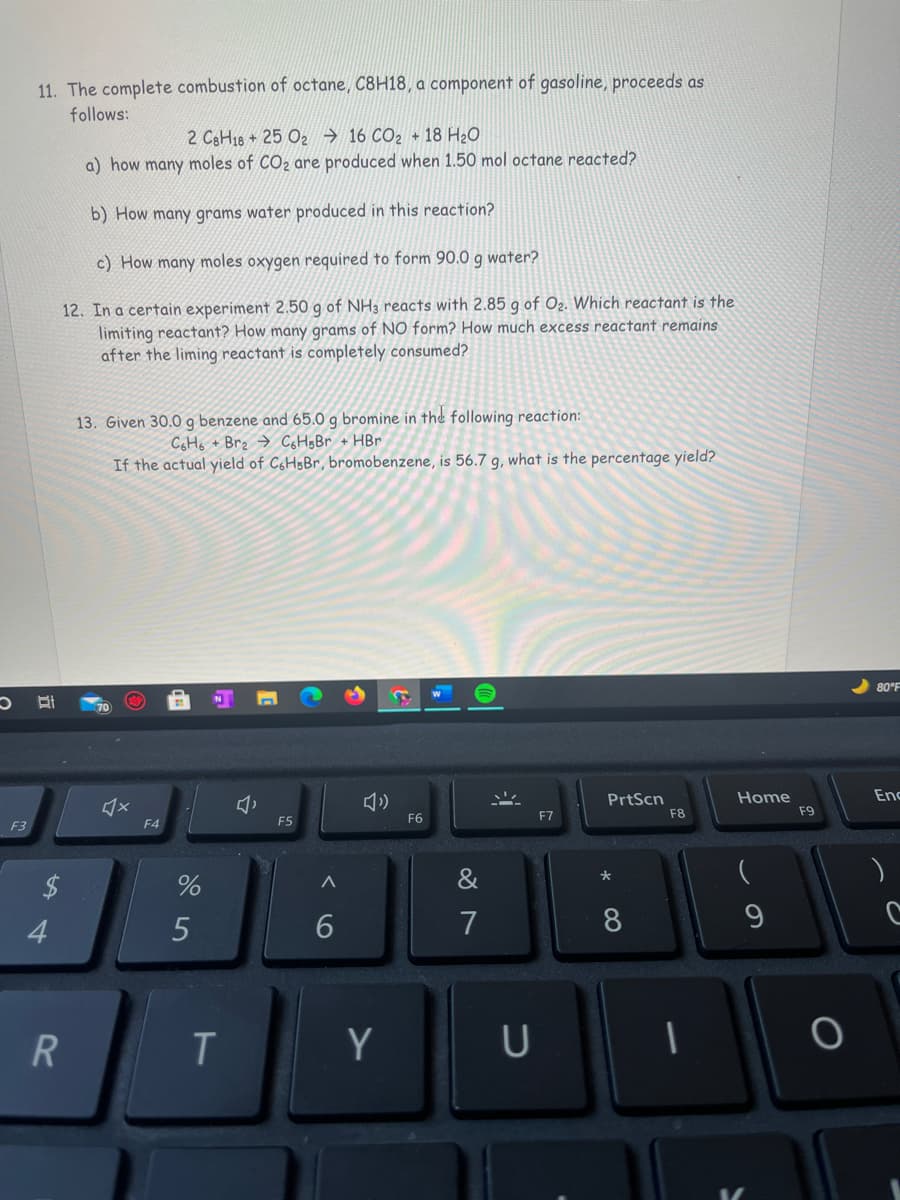11. The complete combustion of octane, C8H18, a component of gasoline, proceeds as follows: 2 CeH18 + 25 O2 → 16 CO2 + 18 H20 a) how many moles of CO2 are produced when 1.50 mol octane reacted? b) How many grams water produced in this reaction? c) How many moles oxygen required to form 90.0 g water?
11. The complete combustion of octane, C8H18, a component of gasoline, proceeds as follows: 2 CeH18 + 25 O2 → 16 CO2 + 18 H20 a) how many moles of CO2 are produced when 1.50 mol octane reacted? b) How many grams water produced in this reaction? c) How many moles oxygen required to form 90.0 g water?
Chapter3: Stoichiometry
Section: Chapter Questions
Problem 124E: DDT, an insecticide harmful to fish, birds, and humans, is produced by the following reaction: In a...
Related questions
Question
11-13

Transcribed Image Text:11. The complete combustion of octane, C8H18, a component of gasoline, proceeds as
follows:
2 CeH18 + 25 O2 → 16 CO2 + 18 H20
a) how many moles of CO2 are produced when 1.50 mol octane reacted?
b) How many grams water produced in this reaction?
c) How many moles oxygen required to form 90.0 g water?
12. In a certain experiment 2.50 g of NH3 reacts with 2.85 g of O2. Which reactant is the
limiting reactant? How many grams of NO form? How much excess reactant remains
after the liming reactant is completely consumed?
13. Given 30.0 g benzene and 65.0 g bromine in the following reaction:
C&Ho + Brz → CgHgBr + HBr
If the actual yield of CHsß
obenzene, is 56.7 g, what is the percentage yield?
80°F
Enc
Home
F9
PrtScn
F6
F7
F8
F3
F4
F5
4
7
8
T
Y
U
Expert Solution
This question has been solved!
Explore an expertly crafted, step-by-step solution for a thorough understanding of key concepts.
This is a popular solution!
Trending now
This is a popular solution!
Step by step
Solved in 4 steps

Knowledge Booster
Learn more about
Need a deep-dive on the concept behind this application? Look no further. Learn more about this topic, chemistry and related others by exploring similar questions and additional content below.Recommended textbooks for you


Chemistry
Chemistry
ISBN:
9781305957404
Author:
Steven S. Zumdahl, Susan A. Zumdahl, Donald J. DeCoste
Publisher:
Cengage Learning

Chemistry: An Atoms First Approach
Chemistry
ISBN:
9781305079243
Author:
Steven S. Zumdahl, Susan A. Zumdahl
Publisher:
Cengage Learning


Chemistry
Chemistry
ISBN:
9781305957404
Author:
Steven S. Zumdahl, Susan A. Zumdahl, Donald J. DeCoste
Publisher:
Cengage Learning

Chemistry: An Atoms First Approach
Chemistry
ISBN:
9781305079243
Author:
Steven S. Zumdahl, Susan A. Zumdahl
Publisher:
Cengage Learning

Chemistry: Principles and Practice
Chemistry
ISBN:
9780534420123
Author:
Daniel L. Reger, Scott R. Goode, David W. Ball, Edward Mercer
Publisher:
Cengage Learning

Introductory Chemistry: A Foundation
Chemistry
ISBN:
9781337399425
Author:
Steven S. Zumdahl, Donald J. DeCoste
Publisher:
Cengage Learning

Living By Chemistry: First Edition Textbook
Chemistry
ISBN:
9781559539418
Author:
Angelica Stacy
Publisher:
MAC HIGHER